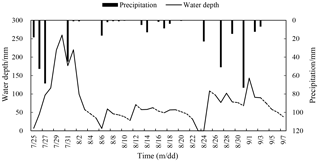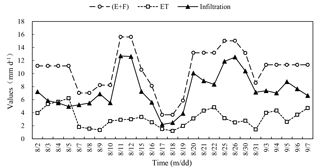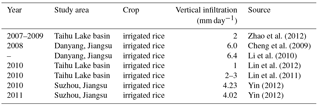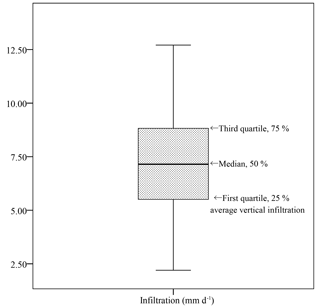the Creative Commons Attribution 4.0 License.
the Creative Commons Attribution 4.0 License.
A new method for indirectly estimating infiltration of paddy fields in situ
Yunqiang Xu
Hongqi Wang
Jingyi He
Infiltration is one of the major procedures in water balance research and pollution load estimation in paddy fields. In this study, a new method for indirectly estimating infiltration of paddy fields in situ was proposed and implemented in Taihu Lake basin. Since when there were no rainfall, irrigation and artificial drainage, the water depth variation process of a paddy field is only influenced by evapotranspiration and infiltration (E+F). Firstly, (E+F) was estimated by deciding the steady decreasing rate of water depth; then the evapotranspiration (ET) of the paddy field was calculated by using the crop coefficient method with the recommended FAO-56 Penman-Monteith equation; finally, the infiltration of the paddy field was obtained by subtracting ET from (E+F). Results show that the mean infiltration of the studied paddy field during rice jointing-booting period was 7.41 mm day−1, and the mean vertical infiltration and lateral seepage of the paddy field were 5.46 and 1.95 mm day−1 respectively.
- Article
(166 KB) - Full-text XML
- BibTeX
- EndNote
Infiltration is one of the major significant factors controlling water use efficiency and influencing the transport of water and chemicals in paddy fields (Wopereis et al., 1994; Aimrun and Amin, 2009; Zhou et al., 2011). It is also an important component for water balance research and pollution load calculating (Huang et al., 2014). Infiltration in flooded paddy fields not only occurs vertically downwards, but also flows into the earthen ridges surrounding the fields (Chen and Liu, 2002; Huang et al., 2003). It means infiltration consists of vertical infiltration and lateral seepage. Vertical infiltration (vertical percolation) is the vertical movement of water beyond the root zone to the water table. In flooded rice fields, there is a continuous downward flow of water from the puddled layer to below the plow pole that basically prevents capillary rise into the root zone (Bouman et al., 2007). Lateral seepage (lateral flow/seepage) is the lateral movement of subsurface water of a paddy field. The study revealed the existence of lateral flow through the ridges to the adjacent lower fields (Janssen and Lennartz, 2007). With well-maintained ridges, lateral seepage is generally small (Bouman et al., 2007). But the study showed lateral seepage flow may occur either underneath well-maintained ridges or through and underneath ill-maintained ridges (Bouman et al., 1994).
The infiltration of paddy fields can be obtained through field experiments monitoring with instruments, such as cylinder, infiltrometer and lysimeter. But it is often prohibitive because of the excessive time and expenditure involved in the execution (Khepar et al., 2000). There are also some difficulties for measuring and calculating the infiltration of paddy fields in situ with multiple runoff outlets. The prediction of infiltration (F) is complicated. Researchers commonly assume a constant infiltration rate which is an overgeneralization of a dynamic process in modeling the water balance of rice fields, through the puddled topsoil. This assumption is at times misleading because the infiltration rate of rice fields is affected by range of soil physical and hydraulic properties, such as structure, texture, conductivity of different layers, and also by the hydrologic environment, e.g. subsoil moisture content, groundwater table depth and ponded water depth on the soil surface (Wickham and Singh, 1978; Khepar et al., 2000; Lin et al., 2014).
Based on synchronous observation of precipitation and water depth, we can use the method (Huang et al., 2014; Zhou et al., 2016a) to estimate the evapotranspiration and infiltration (E+F) of paddy fields in situ. When there were no rainfall, irrigation and artificial drainage, the water depth variation process of a paddy field is only influenced by (E+F). We can choose the steady decline processes of water depth to estimate (E+F) by deciding the steady decreasing rate of water depth. This method can be applied to general paddy fields in situ with multiple runoff outlets and dynamic variation of lowest ridge height during growing season. Evapotranspiration (ET) of paddy fields can be calculated by using the crop coefficient method with synchronous meteorological data. We could get rice evapotranspiration (ETc) of paddy fields with multiplying reference crop evapotranspiration (ET0) which can be determined by the recommended FAO-56 Penman-Monteith equation, by crop coefficients (Kc) according to different rice growing stages (Allen et al., 1998). With the obtained (E+F) and ETc, the infiltration of paddy fields can be calculated by subtracting ETc from (E+F).
2.1 Study area
The experimental paddy field (31.47361∘ N, 119.45020∘ E) located at Liyang, Changzhou, Jiangsu Province is about 900 m2. Deep water irrigation mode under an intermittent irrigation system is adopted. Except for drying period, water depth keeps at least 30 mm. The rice is transplanted in late June, stops irrigation in mid-September, and harvests in mid-November.
This research area is located at the south bank of the lower reaches of the Yangtze River and in Taihu Lake basin, where the topography of fields is almost flat. It belongs to the subtropical humid monsoon climate. The annual mean temperature is 15.4 ∘C, annual precipitation is 1071.5 mm, annual sunshine duration is 2047.5 h, and the annual frost-free period is 227.6 days.
2.2 Instrument installation and data collection
Data used in this paper includes precipitation and water depth in the experimental paddy field and fundamental meteorological data of Liyang. Therein, precipitation and water depth were collected during the rice growing period in 2014 by using pluviograph and automatic mariograph. The observation frequency of water depth was 30 min, while that of precipitation was 10 min. A pluviograph was installed on a fixed tripodal platform in target plot, and a rain barrel was kept vertically 70 cm high away from ground. An automatic mariograph was installed near the ridge in the paddy plot, and the mariograph probe was installed about 2 cm high above the field bottom to avoid being blocked by mud. The probe installation height was kept unchanged during the growing period.
The fundamental meteorological data which is on daily scale, was obtained from Liyang Meteorological Station. The data includes cumulative precipitation (mm), average relative humidity (%), mean wind speed (m s−1), sunshine duration (h), mean air temperature (∘C), maximum air temperature (∘C), minimum air temperature (∘C) and net radiation (MJ m−2 day−1). The mean speed is measured at 2 m above the ground level.
2.3 Data analysis methods
2.3.1 The method for estimating (E + F) of paddy fields
The (E+F) of paddy fields is estimated by using the water balance model (Khepar et al., 2000; Huang et al., 2014). Water balance equation is shown as follow:
where P is the daily precipitation (mm), Rin is the irrigation water inflow (mm), (E+F) is the evapotranspiration and infiltration loss (mm), Rout is the water outflow (mm), and ΔH is the depth variation (mm).
Factors influencing water depth include natural factors and artificial factors. Natural factors mainly include (E+F) and precipitation. Artificial factors mainly include irrigation and artificial drainage. When there were no rainfall, irrigation, and artificial drainage, the steady decline of water depth variation process line is only affected by (E+F) process. Therefore, the Eq. (1) can be simplified as follow:
The key procedure for estimating (E+F) based on synchronous observation of precipitation and water depth is to detect steady decline processes of water depth which were selected to calibrate (E+F) by deciding the steady decreasing rate of water depth. The rice growing period includes four stages, rice regreening, tillering, jointing-booting and maturation. The (E+F) analysis of this paper is applied to the rice jointing-booting stage with water kept in the paddy field all the time.
2.3.2 The method for calculating ET of paddy fields
The crop coefficient method with the recommended FAO-56 Penman-Monteith equation (Allen et al., 1998) is applied to calculate the ET of the paddy field with synchronous meteorological data. In this paper, single crop coefficient method was applied. During the research period of rice jointing-booting stage, water is kept in the paddy field, indicating there is no water stress. The ETc of the paddy field is calculated as follow:
Where ETc is the daily ET (mm day−1) of paddy field, ET0 is the reference crop evapotranspiration (mm day−1), and Kc is the rice coefficient.
-
Reference crop evapotranspiration (ET0)
The FAO Penman-Monteith method defines the reference crop as a hypothetical crop with an assumed height of 0.12 m, with a surface resistance of 70 s m−1, and an albedo of 0.23, closely resembling the evaporation from an extensive surface of green grass. The reference crop evapotranspiration (ET0) is defined and calculated using the FAO-56 Penman-Monteith equation:
where ET0 is reference crop evapotranspiration (mm day−1), Rn is the net radiation at the crop surface (MJ m−2 day−1), G is the soil heat flux density (MJ m−2 day−1), T is the mean daily air temperature at 2 m height (∘C), u2 is the wind speed at 2 m height (m s−1), es is the saturation vapour pressure (kPa), ea is the actual vapour pressure (kPa), es−ea is the saturation vapour pressure deficit (kPa), Δ is the slope vapour pressure curve (kPa ∘C−1), and γ is the psychrometric constant (kPa ∘C−1).
-
Rice coefficient (Kc)
The crop coefficient incorporates crop characteristics and averaged effects of evaporation from the field of the single crop coefficient method. The FAO-56 Penman-Monteith equation gives the recommended values of crop coefficient during different crop growing stages under standard condition. For rice coefficient (Kc), the recommended value was adjusted to the non-standard condition value, using the follow equation:
where Kc,mid is the recommended value of the mid-season stage (including rice jointing-booting stage), RHmin is the mean value for daily minimum relative humidity (%) during the mid-season growing stage, and h is the mean maximum plant height (m).
2.3.3 A new method for indirectly estimating infiltration of paddy fields
Since when (E+F) and ETc of the paddy field have been obtained, the infiltration can be calculated by subtracting ETc from (E+F):
where F is the infiltration loss (mm).
3.1 Estimated (E+F) of the paddy field
The water depth and precipitation of the paddy field during rice jointing-booting stage are shown in Fig. 1. The periods described by black dotted line indicate the steady declines of water depth with no rainfall, irrigation, and artificial drainage. Those steady decline processes can be used for estimating (E+F). Meanwhile, the periods described by solid line indicate the water depth variation mutation periods. In those situation, the (E+F) should be arbitrarily approximated with the mean value of adjacent growing period under the same weather condition. In this paper, we just discussed the estimated (E+F) of water depth during steady decline periods.
Using the proposed method, (E+F) during the rice jointing-booting stage was calculated. As shown in Fig. 2, the maximum (E+F), minimum (E+F) and mean (E+F) were 15.63, 3.69 and 10.62 mm day−1 respectively. Compared with the (E+F) of different paddy fields using the same method, we got the proximate parameter range of (E+F) (Table 1).
3.2 Calculated ETc of the paddy field
According to the related FAO irrigation and drainage papers, rice coefficient (Kc,mid) is 1.2 and the mean maximum rice height is 1.0 m (Allen et al., 1998). ETc of the paddy field is shown in Fig. 2. The maximum ETc, minimum ETc and mean ETc were 6.23, 1.21 and 3.21 mm day−1 respectively.
3.3 Estimated infiltration of the paddy field
In this study, there are 45 days of the rice jointing-booting stage in total and 27 values of infiltration of the paddy field were obtained. As shown in Fig. 2, the maximum infiltration, minimum infiltration and mean infiltration were 12.71, 2.20 and 7.41 mm day−1, respectively.
In practices, vertical infiltration and lateral seepage are not easily separated because transition flows can neither be classified as vertical percolation nor lateral seepage (Wickham and Singh, 1978). Typical combined values for vertical infiltration and lateral seepage vary from 1–5 mm day−1 in heavy clay soils to 25–30 mm day−1 in sandy and sandy loam soils (Bouman and Tuong, 2001). The preferred rate of infiltration is 5–15 mm day−1 in irrigated temperate rice lands where infiltration may be needed to leach organic toxins that can persist from year to year (Wopereis et al., 1994). The vertical infiltration and lateral seepage rates of paddy fields vary from 1 to 6 mm day−1, with the mean value of 3 mm day−1 in Tuanlin, Hubei province, and 3.8 mm day−1 in Jinhua, Zhejiang province (Cabangon et al., 2004). The research observed the vertical infiltration through the plough pan and the lateral seepage on sloping land formed into terraces and showed that the higher the position on sloping land was, the greater the potential of water losses was because of higher vertical infiltration and lateral seepage (Tsubo et al., 2005). The study carried out in Taiwan indicates the vertical infiltration and lateral seepage rates of the flat paddy field through the bottom of the ridge were 4.0 and 3.3 mm day−1 respectively with the plow sole underneath, and 8.5 and 4.5 mm day−1 respectively without the plow sole underneath (Huang et al., 2003). Therefore, in the experimental paddy field with a plow sole in this study, the infiltration range of 2.20–12.71 mm day−1 is moderate and credible, which demonstrates the new method for indirectly estimating infiltration of paddy fields in situ is relatively reliable.
The physical and hydraulic characteristics of the plow sole and the underlying subsoil determine the magnitude and constancy of vertical infiltration rate (Bouman et al., 1994). For many studies, there were usually assumed or measured values in vertical infiltration rates. According to the Jiangsu province actual observed statistic data, the vertical infiltration rate of single crop rice region with clay soil, loam soil and sandy loam soil are 1.2–4, 2.1–5.3 and 5.5–9.8 mm day−1 respectively (Wu, 2015). In the Taihu Lake basin, with approximate soil texture of loam soil, the vertical infiltration of different paddy fields is shown in Table 2, which illustrates the approximate vertical infiltration range of Jiangsu province.
The estimated infiltration values of the paddy filed were analyzed using SPSS 20.0, and the box and whisker plot were shown in Fig. 3. The first quartile (25th percentile) infiltration values of the paddy filed was 5.46 mm day−1. Then the mean vertical infiltration of the paddy field was assumed to be 5.46 mm day−1, according to the previous analysis of vertical infiltration in Jiangsu province and Taihu Lake basin. Subtracting the mean vertical infiltration from mean infiltration of 7.41 mm day−1, the mean lateral seepage of the paddy field turned out to be 1.95 mm day−1. The mean lateral infiltration accounted for 26.4 % of the infiltration, indicating the lateral seepage was also an important component of infiltration in paddy fields in situ with multiple runoff outlets. The lateral seepage should also be paid more attention in future paddy field research.
A new method for indirectly estimating infiltration of the paddy field was put forward. The (E+F) of the paddy field were estimated by deciding the steady decreasing rate of water depth, when there were steady decline processes of water depth. The ET of the paddy field was calculated by using single crop coefficient method with the recommended FAO-56 Penman-Monteith equation. Therefore, the infiltration was calculated by subtracting calculated ET from estimated (E+F). The mean infiltration of the paddy field during rice jointing-booting period was 7.41 mm day−1. By analyzing the infiltration values obtained in this study and the reference vertical infiltration in Jiangsu province and Taihu Lake basin, the mean vertical infiltration and lateral seepage of the paddy field in situ turned out to be 5.46 and 1.95 mm day−1 respectively.
The underlying research data belongs to the project which is not publicly accessible.
The authors declare that they have no conflict of interest.
This article is part of the special issue “Innovative water resources management –understanding and balancing interactions between humankind and nature”. It is a result of the 8th International Water Resources Management Conference of ICWRS, Beijing, China, 13–15 June 2018.
This work is supported by Major Project on Science & Technology of Water
Body Pollution Control & Treatment (2017ZX07301-003).
Edited by: Dingzhi Peng
Reviewed by: two anonymous referees
Aimrun, W. and Amin, M. S. M.: Pedo-transfer function for saturated hydraulic conductivity of lowland paddy soils, Paddy Water Environ., 7, 217–225, 2009.
Allen, R. G., Pereira, L. S., Raes, D., and Smith, M.: Crop evapotranspiration. Guidelines for computing crop water requirements, Fao Irrigation & Drainage Paper 56, FAO, Rome, Italy, 1998.
Bouman, B. A. M. and Tuong, T. P.: Field water management to save water and increase its productivity in irrigated lowland rice, Agr. Water Manage., 49, 11–30, 2001.
Bouman, B. A. M., Wopereis, M. C. S., Kropff, M. J., Berge, H. F. M. T., and Tuong, T. P.: Water use efficiency of flooded rice fields II. Percolation and seepage losses, Agr. Water Manage., 26, 291–304, 1994.
Bouman, M., Lampayan, R. M., and Tuong, T. P.: Water management in irrigated rice: coping with water scarcity, International Rice Research Institute, Los Baños, Philippines, 72 pp., 2007.
Cabangon, R. J., Tuong, T. P., Castillo, E. G., Bao, L. X., Lu, G., Wang, G., Cui, Y., Bouman, B. A. M., Li, Y., and Chen, C.: Effect of irrigation method and N-fertilizer management on rice yield, water productivity and nutrient-use efficiencies in typical lowland rice conditions in China, Paddy Water Environ., 2, 195–206, 2004.
Chen, S. K. and Liu, C. W.: Analysis of water movement in paddy rice fields (I) experimental studies, J. Hydrol., 260, 206–215, 2002.
Cheng, W., Li, Y., Zhu, L., Gu, J., and Yang, L. Z.: Research on the loss of nitrogen in direct-seeding rice field in Taihu Lake basin, Journal of Anhui Agricultural Sciences, 37, 2620–2621, 2717, 2009 (in Chinese).
Huang, H. C., Liu, C. W., Chen, S. K., and Chen, J. S.: Analysis of percolation and seepage through paddy bunds, J. Hydrol., 284, 13–25, 2003.
Huang, N. B.: Study on quantification of non-point source pollution and potential of pollutant emission reduction from paddy fields, MS thesis, Beijing Normal University, Beijing, China, 2014 (in Chinese).
Huang, N. B., Su, B. L., Li, R. R., Yang, W. Z., and Shen, M. M.: A field-scale observation method for non-point source pollution of paddy fields, Agr. Water Manage., 146, 305–313, 2014.
Janssen, M. and Lennartz, B.: Horizontal and vertical water and solute fluxes in paddy rice fields, Soil Till. Res., 94, 133–141, 2007.
Khepar, S. D., Yadav, A. K., Sondhi, S. K., and Siag, M.: Water balance model for paddy fields under intermittent irrigation practices, Irrigation Sci., 19, 199–208, 2000.
Li, Y., Yang, L. Z., and Yin, G. D.: Experimental study on nitrogen leaching in a direct-seeding rice paddy of Taihu Lake Basin, Plant Nutrition & Fertilizer Science, 16, 99–104, 2010 (in Chinese).
Lin, G. Y., Luo, S., Shi, Y. D., and Gao, Y.: Modification and verification of rice field runoff model under non-saturated soil condition, Water Saving Irrigation, 10, 33–36, 41, 2011 (in Chinese).
Lin, G. Y., Shen, A. C., Wang, Y. K., and Gao, Y.: Research on the irrigation and drainage water quantity under the condition of water-saving measures in the area of Taihu Basin based on numerical simulation, Water Saving Irrigation, 1, 11–14, 21, 2012 (in Chinese).
Lin, L., Zhang, Z. B., Janssen, M., and Lennartz, B.: Infiltration properties of paddy fields under intermittent irrigation, Paddy Water Environ., 12, 17–24, 2014.
Tsubo, M., Fukai, S., Basnayake, J., Tuong, T. P., Bouman, B., Harnpichitvitaya, D., Borrell, A., and Shu, F. K.: Estimating percolation and lateral water flow on sloping land in rainfed lowland rice ecosystem, Plant Prod. Sci., 8, 354–357, 2005.
Wickham, T. H. and Singh, V. P.: Water movement through wet soils, in: Soils and rice, International Rice Research Institute, Los Baños, Philippines, 337–357, 1978.
Wopereis, M. C. S., Bouman, B. A. M., Kropff, M. J., Berge, H. F. M. T., and Maligaya, A. R.: Water use efficiency of flooded rice fields I. Validation of the soil-water balance model SAWAH, Agr. Water Manage., 26, 277–289, 1994.
Wu, D.: Drainage processes and the lateral drainage effect of the main ditches on the paddy fields in the Plain River Network Regain, MS thesis, Xi'an University of Technology, Xi'an, China, 2015 (in Chinese).
Yin, H. F.: Effect of different water and nitrogen conditions on growth and nitrogen leaching of rice, MS thesis, Nanjing Agricultural University, Nanjing, China, 2012 (in Chinese).
Zhao, X., Zhou, Y., Min, J., Wang, S., Shi, W., and Xing, G.: Nitrogen runoff dominates water nitrogen pollution from rice-wheat rotation in the Taihu Lake region of China, Agr. Ecosyst. Environ., 156, 1–11, 2012.
Zhou, J. W., Su, B. L., Huang, N. B., Guan, Y. T., and Zhao, K.: In situ experiment on non-point source pollution in paddy fields, Acta Scientiae Circumstantiae, 36, 1145–1152, 2016a (in Chinese).
Zhou, J. W., Su, B. L., Huang, N. B., Guan, Y. T., and Zhao, K.: Runoff pollution experiments of paddy fields under different irrigation patterns, Environm. Sci., 37, 963–969, 2016b (in Chinese).
Zhou, S., Sugawara, S., Riya, S., Sagehashi, M., Toyota, K., Terada, A., and Hosomi, M.: Effect of infiltration rate on nitrogen dynamics in paddy soil after high-load nitrogen application containing 15N tracer, Ecol. Eng., 37, 685–692, 2011.










